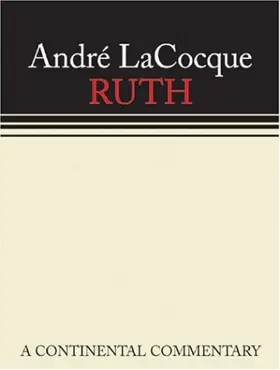

Ruth
Pages
187 pages
Publisher
Fortress Press
Published
11/1/2004
ISBN-13
9780800695156
This volume provides a readable introduction to the narrative book of Ruth appropriate for the student, pastor, and scholar. LaCocque combines historical, literary, feminist, and liberationist approaches in an engaging synthesis. He argues that the book was written in the post-exilic period and that the author was a woman. Countering the fears and xenophobia of many in Jerusalem, the biblical author employed the notion of h.esed (kindness, loyalty, steadfast love), which transcends any national boundaries.
LaCocque focuses on redemption and levirate marriage as the two legal issues that recur throughout the text of Ruth. Ruth comes from the despised people of Moab but becomes a model for Israel. Boaz, converted to the model of steadfast love, becomes both redeemer and levir for Ruth and thus fulfills the Torah. In the conclusion to his study, the author sketches some parallels with Jesus' hermeneutics of the Law as well as postmodern problems and solutions.
Reviews
a very recent
and thorough critical commentary with attention to issues of language, culture, and
interpretation
This commentary adds a valuable volume on Ruth to the already well-established Continental Commentary series. The author is Emeritus Professor of Old Testament at the Chicago Theological Seminary, and the book represents a translation of his original French version published the same year. In a lengthy introduction (1�32), the author treats typical introductory matters (e.g., textual criticism, literary criticism, date, theology). He joins those scholars who date the book to the era of Ezra and Nehemiah (or slightly thereafter), who believe its intention is to counteract the policy toward foreigners typical of that era, and who define its genre as that of a novella. Unlike many, however, he accepts the genealogy as integral to the book, though fictional in origin. More important, the author also discusses the book of Ruth�s �social environment� (21�27)�that is, the social issues of the Second Temple period that underlie it. This discussion is crucial since the author characterizes his work as a �socio-legal commentary� (2), and the reader soon discovers in the commentary (33�154) how profoundly that social setting, especially the negative attitude in Judah toward foreigners, has shaped his interpretation. Structurally, the commentary�s four main s ections correspond to Ruth�s four chapters, with each section broken up into literary subunits. In each subunit the author first lists quotations of important intertextual �Reference Passages� and then offers lengthy introductory remarks, his own translation, and notes on specific verses. A lengthy bibliography of predominately English-language sources concludes the volume (155�76), but most of those sources do not find their way into the footnotes.
[Full Review]

